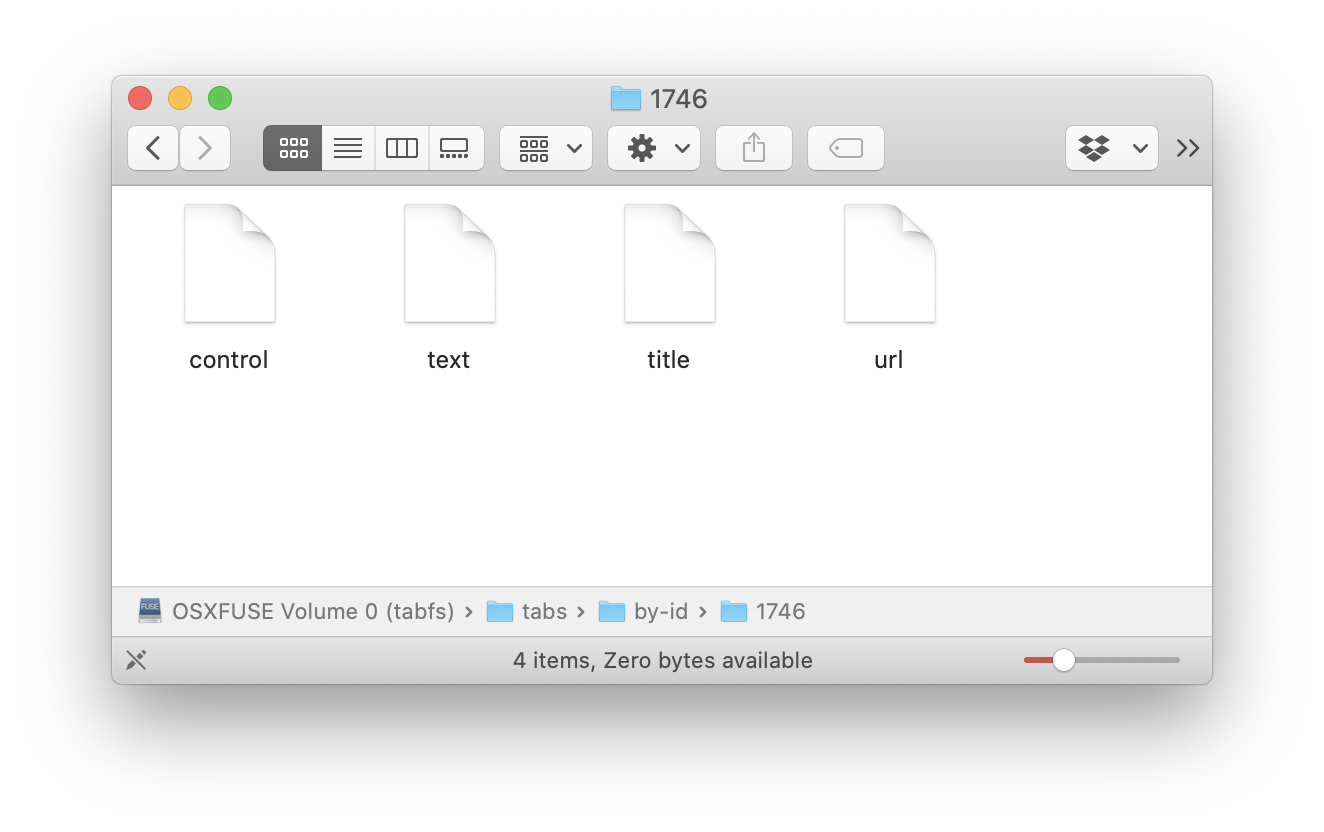|
|
||
|---|---|---|
| doc | ||
| extension | ||
| fs | ||
| .gitignore | ||
| .gitmodules | ||
| install.sh | ||
| README.md | ||
TabFS
Mount your browser tabs as a filesystem!

Each of your open tabs is mapped to a folder with a bunch of control and live-updating content files inside it. (TODO: update as I add more)

This gives you a ton of power, because now you can apply all the existing tools on your computer that already know how to deal with files -- terminal commands, scripting languages, etc -- and use them to control and draw information from your browser. You don't need to write a browser extension from scratch every time you want to do anything.
Examples of stuff you can do!
(assuming your shell is in the fs subdirectory of this repo)
(TODO: more of these)
List the titles of all the tabs you have open
$ cat mnt/tabs/by-id/*/title
GitHub
Extensions
TabFS/install.sh at master · osnr/TabFS
Alternative Extension Distribution Options - Google Chrome
Web Store Hosting and Updating - Google Chrome
Home / Twitter
...
Close all Stack Overflow tabs
$ echo remove | tee -a mnt/tabs/by-title/*Stack_Overflow*/control
Save text of all tabs to a file
(wip, FIXME)
$ cat mnt/tabs/by-id/*/text > text.txt
Setup
disclaimer: security, functionality
First, install the browser extension.
Then, install the C filesystem.
1. Install the browser extension
(I think it will work on Edge or Opera or whatever, too. You'll need to change the native messaging path in install.sh in those cases. Not sure about Safari.)
in Chrome
Go to the Chrome extensions page. Enable Developer mode (top-right corner).
Load-unpacked the extension/ folder in this repo.
Make a note of the extension ID Chrome assigns. Mine is
jimpolemfaeckpjijgapgkmolankohgj. We'll use this later.
in Firefox
You'll need to install as a "temporary extension", so it'll only last in your current FF session.
Go to about:debugging#/runtime/this-firefox.
Load Temporary Add-on...
Choose manifest.json in the extension subfolder of this repo.
2. Install the C filesystem
First, make sure you git submodule update --init to get the
fs/cJSON and fs/base64 dependencies.
And make sure you have FUSE. On Linux, for example, sudo apt install libfuse-dev. On macOS, get FUSE for macOS.
$ cd fs
$ mkdir mnt
$ make
Now install the native messaging host into your browser, so the extension can launch and talk to the filesystem:
Chrome and Chromium
Use the extension ID you copied earlier.
$ ./install.sh chrome jimpolemfaeckpjijgapgkmolankohgj
or
$ ./install.sh chromium jimpolemfaeckpjijgapgkmolankohgj
3. Ready!
Go back to chrome://extensions or
about:debugging#/runtime/this-firefox and reload the extension.
Now your browser tabs should be mounted in fs/mnt!
Open the background page inspector to see the filesystem operations stream in. (in Chrome, click "background page" next to "Inspect views" in the extension's entry in the Chrome extensions page; in Firefox, click "Inspect")

This console is also incredibly helpful for debugging anything that goes wrong, which probably will happen.
(My OS and applications are pretty chatty! They do a lot of operations, even when I don't feel like I'm actually doing anything.)
Design
fs/: Native FUSE filesystem, written in Ctabfs.c: Talks to FUSE, implements fs operations, talks to extension.
extension/: Browser extension, written in JSbackground.js: The most interesting file. Defines all the synthetic files and what browser operations they invoke behind the scenes.
When you, say, cat a file in the tab filesystem:
-
catmakes something like areadsyscall, -
which goes to the FUSE kernel module which backs that filesystem,
-
FUSE forwards it to the
tabfs_readimplementation in our userspace filesystem infs/tabfs.c, -
then
tabfs_readrephrases the request as a JSON string and forwards it to the browser extension over 'native messaging', -
our browser extension in
extension/background.jshandles the incoming message and calls the browser APIs to construct the data for that synthetic file; -
then the data gets sent back in a JSON native message to
tabfs.cand and finally back to FUSE and the kernel andcat.
(very little actual work happened here, tbh. it's all just marshalling)
TODO: make diagrams?
license
GPLv3
hmm
processes as files. the real process is the browser.
browser and Unix
it's way too hard to make an extension. even 'make an extension' is a bad framing. lightness
open input space -- filesystem
now you have this whole 'language', this whole toolset, to control and automate your browser
OSQuery
fake filesystems talk
Screenotate
rmdir a non-empty directory